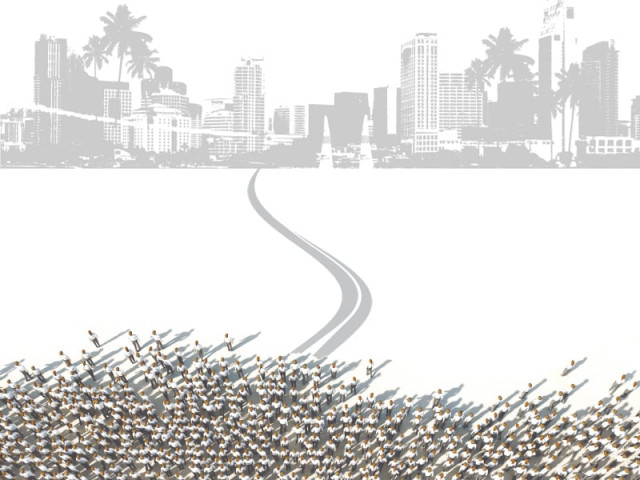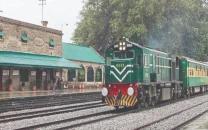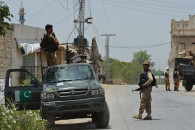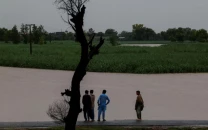Sign of progress?: When cities feed whole villages
Pakistan’s rapid urbanisation comes at cost of agriculture production.

Pakistan’s rapid urbanisation comes at cost of agriculture production. DESIGN: FAIZAN DAWOOD
In a cramped two bedroom house in Dalmia, Karachi, Asadullah Sheikh lives with his 5 children, mother and wife. This is his sixth year in Karachi. Previously, Shaikh was a smallholder farmer and owned 11 acres of land in Sajawal.
The artificial price hike of agricultural lands between 2005 and 2007 tempted Shaikh - like many other farmers- to move to the city. He sold his land, got enough money to buy a motor cycle, paid his debts, set up a small kiryana store and made Karachi his home. “My 11 acres are lying uncultivated,” he says with a tinge of remorse. Sheikh is one of those who form Pakistan’s growing urban population, making Pakistan a country with a very rapid urbanisation rate.
A 2008 report by UN Population Fund reported that the share of the urban population in Pakistan almost doubled from 17.4 per cent in 1951 to 32.5 per cent in 1998.
More than 60% of the population of urban Sindh lives in Karachi, which according to a “City Mayors 2011 survey” has become one of the largest cities in the world with a population of 15.5 million, with other estimates claiming it may be 18 million.
Karachi is just a case in point. Eight key cities in Pakistan are caving under the burden of high-density concentration of population. At the same time, it is becoming tougher for Pakistan’s farmers to continue to live in rural areas and survive on agriculture. According to Dr Vaqar Ahmed of the Sustainable Development Policy Institute, a lot has to do with untargeted government subsidies for products consumed in urban areas such as wheat, sugarcane and rice. “What a farmer produces fetches a low price. But what a worker in an urban area produces fetches better returns. Moving to cities is an attractive option. The urban sprawl is very market driven.”

While city-dwellers complain about how cities are becoming crowded, the reasons for this urbanisation are hardly understood. Tariq Bucha, President of Pakistan Farmer’s Association, while talking to The Express Tribune, says that 85 to 87% farmers of Pakistan live below the subsistence level, which means they own less than 12 and a half acres. “Inheritance laws are an important factor here. Every time a person dies, his lands are divided into smaller shares among his children. Small pieces of land are economically unviable. In an absence of a marketing infrastructure and access for our farmers, the most attractive option for them is to sell the 3 to 4 acres they have, and move,” said Bucha.
In the 36th Governing Council of the United Nations International Fund for Agricultural Development (IFAD), held in Rome in February, agency President Kanayo Nwanze reminded partners that a boom in agriculture can prompt twice more growth in an economy.
“The emergence of higher and more volatile food prices, combined with dramatic droughts, floods, and famines, have concentrated world attention on the question of how to feed a global population that is over 7 billion and growing. Today, agriculture is centre stage,” Nwanze said.
Urban food choices and migration – the missing link
In 2008, the world’s urban population exceeded its rural population for the first time. UN projections suggest that the world’s urban population will grow by more than a billion people between 2010 and 2025, while the rural population will hardly grow at. According to the research paper “Urbanisation and its implications for food and farming” (David Satterthwaite, Gordon McGranahan and Cecilia Tacoli), it is likely that the proportion of the global population not producing food will continue to grow, as will the number of middle and upper income consumers whose dietary choices are more energy- and greenhouse gas emission-intensive (and often more land-intensive) and where such changes in demand also bring major changes in agriculture and in the supply chain.
While urbanisation is seen as a sign of progress, this research says that with urbanization, there will be rising demands for meat, dairy products, vegetable oils and ‘luxury’ foods, and this implies more energy-intensive production and, for many nations, more imports. Also, dietary shifts towards more processed and pre-prepared foods, in part in response to long working hours and, for a proportion of the urban population, with reduced physical activity, affects the agricultural supply chain.
“This trans-shifting has effects on demand of crops. Who eats jawaar (millet) and baajra (sorghum) now? We are moving away from organic food to synthetics,” says Bajwa, commenting on how city dwellers’ food choices indirectly result in mass exodus from villages to cities.
Published in The Express Tribune, March 2nd, 2013.



















COMMENTS
Comments are moderated and generally will be posted if they are on-topic and not abusive.
For more information, please see our Comments FAQ